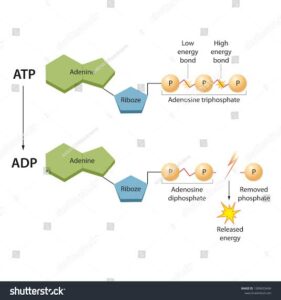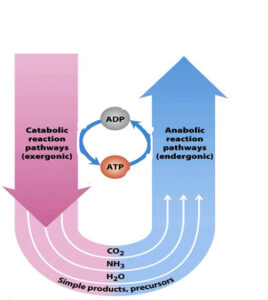Back to: MICROBIOLOGY 200 LEVEL
Welcome to class!
Hello super scholar! I’m really glad to see you today—your love for learning is something special. Imagine trying to run your phone without battery power, or cooking jollof rice with no gas or firewood. Impossible, right? In the same way, cells need a steady supply of energy to stay alive and do their work. That’s where **ATP—the energy currency of the cell—**comes in. Let’s learn how this tiny molecule powers life!
Atp And Energy Currency Of The Cell
What is ATP?
ATP stands for Adenosine Triphosphate. It is often called the energy currency of the cell because it stores and provides the energy needed for all cellular activities. Just like you use naira to pay for things at the market, cells use ATP to “pay” for work—whether it’s moving, growing, dividing, or transporting materials.

Structure of ATP
ATP is made up of three parts:
Adenine – a nitrogenous base
Ribose – a five-carbon sugar
Three phosphate groups – the key to its energy power!
The energy in ATP is stored in the bonds between the phosphate groups, especially the last phosphate bond. When the cell breaks that bond, energy is released, and ATP becomes ADP (Adenosine Diphosphate). It’s like spending money—when you remove ₦1,000 from your wallet (ATP), you’re left with less cash (ADP).
How is ATP Made?
ATP is produced in the mitochondria—the cell’s “powerhouse”—during a process called cellular respiration. This happens in three main stages:
Glycolysis – breaks down glucose into smaller molecules (in the cytoplasm).
Krebs cycle (or Citric Acid Cycle) – produces energy-rich compounds.
Electron Transport Chain – produces most of the ATP using oxygen.
This entire process converts glucose (from food) into ATP—clean, usable energy for the cell.
Functions of ATP in the Cell
ATP is used in almost every activity inside the cell. Some examples include:
Muscle contraction – e.g. your heart beating or you lifting your hand.
Active transport – moving materials against a gradient (like pushing water uphill).
Biosynthesis – making new molecules like proteins and DNA.
Cell division – helping cells grow and reproduce.

Sending signals – in nerve cells for communication.
Think of ATP like the battery in your torchlight. No matter how strong the torch is, if there’s no battery, there will be no light. Similarly, a cell without ATP is like a car without fuel—it simply can’t function.
Summary
- ATP (Adenosine Triphosphate) is the energy currency of the cell.
- It stores energy in the bonds between its phosphate groups.
- When one phosphate is removed, energy is released and ATP becomes ADP.
- ATP is made during cellular respiration, especially in the mitochondria.
- It powers many cell processes like movement, building molecules, and transport.
Evaluation
- What does ATP stand for and why is it called the energy currency of the cell?
- Name the three components of an ATP molecule.
- What happens to ATP when it releases energy?
- List two ways cells use ATP.
You’re doing amazingly well! You’ve just learned how cells stay alive and active, and that makes you a true biology hero. Keep that energy high, and always remember—just like ATP powers the cell, your determination powers your success. Keep going strong with Afrilearn. See you in the next exciting lesson!
